Third Term Basic Tech Lesson Note for JSS2
ACCESS ALL LESSON NOTES
ACCESS ALL QUESTIONS AND ANSWERS
ACCESS ALL WORKSHEETS
ACCESS ALL JOBS ACCESS
ACCESS WAEC QUESTIONS AND ANSWERS
Week 1
Topic: ENERGY BASED TECHNOLOGICAL APPLIANCES
CONTENT:
- Electrical energy to heat energy
- Chemical energy to heat energy
- Electrical energy to mechanical
- Mechanical energy to Electrical energy
Introduction
We shall discuss the following:
1. Operation of a pressing iron, Operation of an electric kettle, operation of cookers, water heaters, gas lamp, gas cooker, kerosene cooker and charcoal pressing iron
2. Principles of evaporation leading to cooling by refrigeration
3. Operation of a compressor as responsible for the circulation of refrigerants
4. Principle of operation of electric fan and grinder
5. Working principle of generator bicycle-dynamo
1 (a). Operation of Pressing Iron (Electrical)
The basic principle of the appliance is that a heating element is built into it. The heating element is made of a material with high resistance and high melting point.
As current flows through the circuit, the immense electrical energy used to overcome the resistance is turned into heat energy and the heat thus produced is used in ironing. The high melting property of the element enables it to withstand the great heat. The electric iron is made up of the following parts.
(a) A nichrome element wound on mica former
(b) Two heavy stainless steel plates in between which the element is fixed. The weight of the steel plates applying pressure which, coupled with the heat from the element, smoothens the clothes being ironed.
(c) An asbestos pad, a poor conductor of heat, which is fitted to the upper steel plate to minimize the upward flow of heat from the element.
(d) Mica plates which insulate the steel plates from electricity but conducts the heat from the elements to the steel plate for ironing.
(e) A bimetallic thermostat which controls the extent to which the plates are heated.
The temperature produced by such irons varies between 1210C and 2040C. The lower temperature range is used for ironing synthetic materials like nylon, terrylene and so on, while the higher range of temperature is used for pressing cotton materials.

(b) Operation of an electric Kettle
This is made up of the following:
(a) A chrome-plated aluminium or copper body.
(b) A nichrome element encased in a metal tube and insulated with a refractory material such as magnesia. The tube must be watertight to avoid water leaking into the element. When the element is heated, the magnesia insulation conducts the heat to the metal tube which is in contact with the water to be heated.
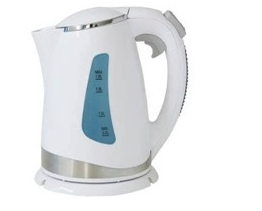
(c) Operation of an electric cooker
A modern electric cooker has several cooking points so that several items can be cooked at the same time. Each cooking point consists of a steel plate in which two nichrome elements spiral shape are fixed. The spiral shape of the elements makes it possible for a greater length of the element to be contained in a small space. We should remember that the longer the elements, the greater its resistance and also the greater the heat produced.
The elements are encased in magnesia to insulate them from the steel plate. When the electric circuit is switched on, the element heats the metal disc to cooking temperature.
(d) Water heater (Free outlet)
There are various types of electric water heater such as (1) Free outlet (Pressure type and (3) Cistern types. They operate on the basic principle of electric energy converted into heat and by conduction, cold water is heated. The main differences are (a) The free outlet type supplies limited hot water by the inrush of cold water to displace the heated quantity at turning the only tap. Use in the bathrooms with single tub.
The pressure type has an advantage of its ability to supply many hot water outlet points since many taps can be fitted on its outlet pipe but will always depend on the supply mains pressure. If a free outlet water is filled with a cistern, smaller quantity of hot water can be ready for use always as in the cistern type water heater. An example of this is the cylindrical tank found in bathrooms. Like the electric kettle, the ceramic or metal tank contains nichrome elements insulated with magnesia and enclosed with a metal tube. Water heater by the immersion of the element, rises up in the tank thereby forcing the topmost hot water to flow freely outward.
Conversion of Chemical Energy to Heat Energy
The commonest method of obtaining heat for cooking and other purposes in our homes is by burning fuel such as firewood, charcoal, kerosene and gas. Burning is a combustion process in which chemical energy is converted to heat energy. During the combustion process, heat is released. Solid fuel such as wood and charcoal are complex compound of carbon, nitrogen, metal and sulphur, while gaseous fuel of various types are compounds of hydrogen and carbon.
Gaseous fuel is usually referred to as hydrocarbon. Examples of hydrocarbon are butane (cooking gas) and kerosene. In the process of burning, oxygen from the air combines with hydrocarbons to form carbon(iv)oxide and water in form of steam, and heat is released. Many appliances have been designed to convert chemical energy to heat energy for domestic and industrial uses. Some of them are described below:
(e) Gas Lamp
A gas lamp consists of a gas cylinder, a pipe and cylindrical or spherical glass. The natural gas (butane) is compressed into the cylinder. A metal pipe is fixed at the top of the cylinder. At the upper end of the metal pipe, the mantle is fixed. A regulator is fixed on the pipe to control the amount of gas that comes out fir burning. To use the gas lamp, the regulator is opened and the gas that appears at the top of the pipe is ignited. The gas burns at a very high temperature and the flame that results from the burning heat mantle.
(f) Gas Cooker
The principle of operating a gas cooker is similar to those of the gas lamp except that the cooking unit is not fixed on top of the cylinder; rather it is connected to the cylinder by a rubber tube. Also, the metal pipe through which the gas flows to the burning points are built into the cooker. A metal disc is placed at the burning point to guide abs spread the flame. The very hot flame resulting from the burning of the gas flows out and provides the heat used in the cooking.
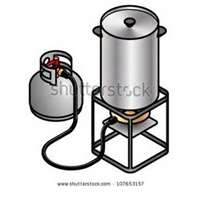
(g) Kerosene
Kerosene is a liquefied gas. Its chemical action during burning is similar to that of cooking gas. The kerosene cooker consists of the stand, a gas container, perforated cylinders are usually three in number and the assembled concentrically. The innermost and the middle ones are perforated to allow in air during burning while the outermost one is not. To cook with the cooker, the metal pipe is opened, kerosene flows from the container through the wick, which provides easy passage for the kerosene to travel to the top of the wick and evaporate. When ignited, the vaporized kerosene burns and provides the heat required for cooking.

(h) Charcoal Pressing Iron
Charcoal is an incompletely burnt wood, which is very high in carbon content. The pressing iron is a heavy steel container whose bottom plate is in the form of an isosceles triangle. The cover plate, which has the same shape as the bottom plate, is hinged to the main container at the base of the sides to let in air.
When the container is loaded which charcoal and ignited, it burns to release heat energy. The heat energy heats up the steel container, which is then used for pressing clothes.
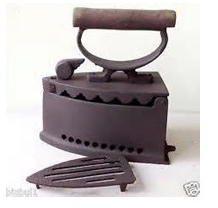
Week 2
Topic: PRINCIPLES OF OPERATION OF AC MOTOR MACHINES
CONTENT:
- Electric fan, Shaver, Washing machine, loud speaker, Blender, etc
(a) The Electric Fan
The electric fan is basically an induction motor of the squirrel – cage rotor type in most cases. The shaft of the motor at the fan blade end is provided with a flat side onto which the fan blade is tightly fitted to and secured with a screw or a left hand thread cap to prevent the fan blade form becoming loose and sliding off during motion.
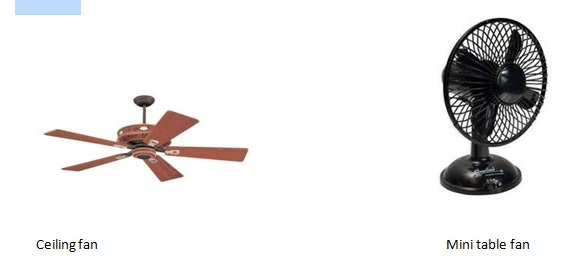
(b) The Grinder
Any machine which employs electric motor as its ‘prime movers’ turning force in order to produce granulated, paste or powdered form from solid substances e.g. maize, sorghum, soybeans, groundnuts, dried beans, etc. Grinder in many case perform the function of blending e.g. liquidizing of soft fruits and plants products e.g. fruits, tomatoes, soft pepper, onions, etc. Grinding stones are usually limited to benches and hand tools for metal surface. Below is the construction and operation of a regular grinder for foodstuffs only.

Grinding Shaft
The figure shows the complete assembly of grinder with is prime mover i.e. the electric motor coupled with a set of pulley and belt.
The grinding shaft image above shows the actual grinder, which is a small cross sectional rod, welded to a larger shaft carefully chosen to turn in the grinder with no space for wastage of items being grinded.
Week 3
Topic: PRINCIPLES OF OPERATION OF BICYCLES, GENERATORS, DYNAMOS
The bicycle electrical power supply is in a few different methods but this section will treat the method where a dynamo is used. A dynamo is a generator but supplies direct current (D.C.) only. The other generator is referred to as “alternator” because its output is collected via slip rings instead of split rings or commutators.
Operation: The dynamo is hinged for huge movement but with a firm bracket. When in use, it is pushed against the cycle tyre on its nulled rubber cap which is free to rotate at the pedaling speed of the rider.
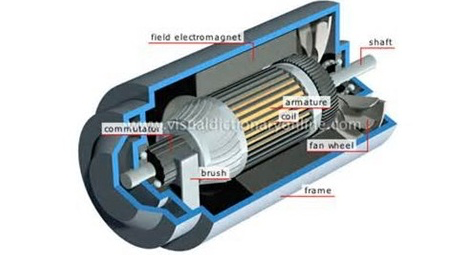
The armature and the commutator rotate between the carbon brushes are in a fixed position so that the conductors situated at a right angle to the magnetic field always release its current to the same brush therefore maintaining same polarity of the generated output e.m.f. i.e. polarized + and – (D.C.) similar to a battery.
Week 4
Topic: TRANSMISSION OF ELECTRICITY
INTRODUCTION
Electrical power is said to be transmitted when it is conveyed from it source of generation to distances far way or near the sending end.
The positions or destinations at which the power is received is referred to as “The receiving end”. The equipment, required for the transmission is referred to as transmission equipment such as generator (alternators), synchronizing/control panel, circuit breakers, substations, transformers, insulators, power lines, uprisers, etc.
Electricity can be generated at low frequencies by using hydropower as in Kainji Dam, burning gas as in Afam Power station and Egbin Power station, and burning charcoal as in Oji River power station. In each of these big power stations, electricity is generated for the use of people located at, and away from the source of generation. For example, the electric power generated at the Kainji is used by people in Kainji as well as people in Lagos, a distance of 560km from Kainji. This is one of the major advantages of electricity. It can be generated at a point and can be made available in place far from the point of generation. This is made possible by providing transmission lines to transmit electricity to sub stations, from where it can be distributed to different consumers.
Here in, the student is introduced to the basic principles of transmission of electricity from the source of generation, and its eventual distribution to the consumer.
Basic Principles of Transmission of Electricity at Low Frequencies
Electricity is transmitted by underground cables or overhead lines on poles or towers over considerable distances. The lines which are usually steel, cored aluminium or hard drawn copper, are called the transmission lines. The transmission of electric power is usually at very high voltage and at low frequency in the range of 50 cycles per second (referred to as 50 Hertz or 50 Hz) in most part of the world and up to 60 Hz in some countries. The reason for generating and transmitting at higher voltages than required in premises and appliances will be discussed later.
Basic Principles of Transmission at High Frequencies
The transmission of electricity at high frequency takes place at low voltage. Instead of using high tension transmission power, it uses low tension transmission power. The frequency cuts across a broad band so that many networks can operate at the same time.
Appliances like radio, television and telecommunication gadgets operate on these frequencies. The frequencies or bands include AM, MW, SW and FM bands (this is for the radio frequencies). For the television band, we have the UHF, VHF and SHF channels.
The basic principle in the transmission of electricity at high frequency lies in the principle of the tank circuit. It is the conversion of audio or visual signals into electromagnetic waves, which is radiated from a sending aerial into space, where the receiving aerial cuts across it, to be transmitted to the final consumers.
Differences between Low and High Frequency Transmission
Low Frequency can travel around the world
High Frequency are mostly straight line of sight
Low Frequency has low energy power
High Frequency have a lot of energy power
Low Frequency (AM) can have interference by a lot of things
High Frequency (FM) have clearer reception over a wide range
TO GET YOUR COMPLETE LESSON NOTE AT AN AFFORDABLE PRICE, HIT THE WHATSAPP BUTTON BELOW
ACCESS ALL QUESTIONS AND ANSWERS
ACCESS WAEC QUESTIONS AND ANSWERS


